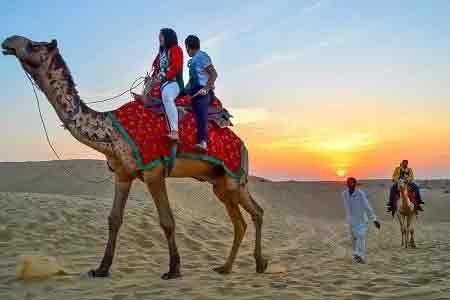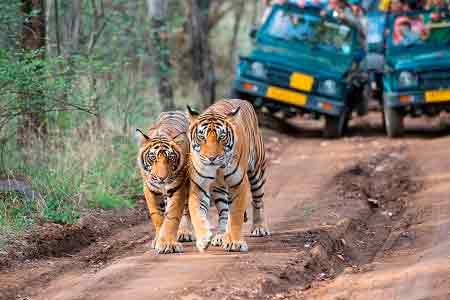

Sawai Madhopur is a city and Municipal Corporation (Nagar Parishad) in the Sawai Madhopur District in Rajasthan state, India. It is the administrative headquarters of Sawai Madhopur District of Rajasthan. Sawai Madhopur District comes under Bharatpur Divisional Commissionerate. Near to Sawai Madhopur is the Ranthambore National Park which is 7 km from the railway station and Ranthambore Fort, a UNESCO World Heritage Site. In Sawai Madhopur is the Trinetra Ganesh temple. Guavas are grown in the 40 Km region around the City.
Ranthambore Fort
The noteworthy Ranthambore Fort was built by the Chauhan rulers in the 10th century. Due to its strategic location, it was ideal to keep the enemy at bay. The fort is also related to the historical legend of the royal women performing ‘jauhar’ (self-immolation) when the Muslim invader Alauddin Khilji laid siege on this fort in 1303. The fort is characterised by temples, tanks, massive gates and huge walls.
Ghushmeshwar Temple
Enshrined in the Puranas, the Ghushmeshwar Temple is believed to be 12th or the last of the Jyotirlingas of Lord Shiva. Situated at the Siwar village in Sawai Madhopur, this temple has many mythological stories weaved around it. The most prominent, and popular story tells of the greatness of Lord Shiva, who resurrected his devotee Ghusma’s son, and even promised to abide in Devagiri hills as Ghushmeshwar after her name, Ghushma.
Tonk
Lying 96 kms from Jaipur on the route to Ranthmabore, Tonkwas once the stronghold of the Pathan tribesmen of Afghanistan. By and by this quiet township passed through the hands of several rulers. Modern Tonk was founded by the Nawab Ameer Khan as a result of a treaty with the British in 1818. Tonk has several colonial buildings, painted mosques, quasi-hindu architecture and a repository of ancient manuscripts and books. Tonk has several other names by which it is known, like- Rajasthan ka Lucknow, Adab ka Gulshan, Hindu Muslim Ekta ka Masaan and many more.
Sunheri Kothi
Constructed in 1824 by Nawab Ameer Khan, the Sunheri Kothiwas later renovated by Nawaab Ibrahim Ali Khan. The exterior of the Mansion of Gold completely belies the grandeur within. In-lay work with mirrors, gilded stucco, coloured glass, mosaic and lapez lazuli, painted and polished floors reflecting in the stained glass window leaves visitors completely impressed. This is a beautiful specimen of Hindu Muslim cohesion of architecture.
Jama Masjid
Located in the heart of the bustling city is the JamaMasjid, Rajasthan’s finest mosque. Delicately frescoed inside and out with intricate patterns, mosque still contains some of the ancient lamps. This fine piece of architecture began construction under the first Nawab of Tonk, Nawab Ameer Khan and completely by his son in 1298.
Hathi Bhata
Situated just 10kms from Kakod on the route to Sawai Madhopur is Hathi Bhata,carved out as a single stone in the shape of a huge life size stone elephant. To top it up, inscription on the rock tells us the story of Raja Nal and Damyanti. This monument was constructed in the year 1200 by Ram Nath Slat, during the reign of Sawai Ram Singh.
Amreshwar Mahadev temple
Nestled amidst the high hills on the way to Ranthambore National Park is the sacred Amreshwar Mahadev temple. The representation of 12 Jyotir Lingas and a 11ft high Shivling attracts a lot of devotees to come and seek blessing of Lord Mahadev.
Khandar Fort
The imposing Khandar Fort is a place worth visiting and is situated just 45 kms from Sawai Madhopur. This magnificent fortification was long ruled by the Sisodia Kings of Mewar after which it was taken over by the Mughals. It is believed that the king of this fort never lost a war.
Kaila Devi temple
About 23kms from Karauli stands the Kaila Devi temple dedicated to the Mother Goddess. In the months of March-April and September-October, devotees celebrate the colourful Kaila Devi fair and worship the Goddess for the fulfilment of their wishes.
Sri Mahavirji
Located on the banks of Gambhiri River, stands the pilgrimage site dedicated to Sri Mahavirji, the 24th Jain Tirthankara.This temple has a long story of existence and is known to be one of the miraculous pilgrimages of Jains.
Ranthambore
Situated 14 km from Sawai Madhopur, the Ranthambore Park gets its name from the Ranthambore Fort situated within its boundaries. The National Park, situated amidst the Aravalis and Vindhya ranges is spreads over an area of 392 sq.km of thick forest punctuated with pleasant waterfalls. It is home to the elusive tiger, other animals found here include chinkara, sambhar, cheetal and over 300 species of birds.
Shilpgram Museum
Located near the Ramsinghpura village, about 9 km from Sawai Madhopur is the Shilpgram Museum. Though we name it as a museum, it is more of a craft village that encompasses and showcases the tremendous diversity in arts, crafts, and cultures of the various Indian states. Shilpgram is a living ethnographic museum, established with an aim to empower craftspeople, especially women, to use their skills as means of economic self-sufficiency, and to bring to the world the cultural heritage of Rajasthan. An embodiment of Rajasthani culture and heritage through arts and crafts, Shilpgram is a site that needs to be seen to be understood and appreciated. If you have a keen eye for arts and crafts and haven’t been to Shilpgram yet, it’s time to add it to your bucket list!




































Rajasthan Tour Packages are arguably the most sought after holiday packages in India. The very name Rajasthan conjures up the image of hill top fortresses, maharajas with scimitars riding the painted elephants, the exquisitely carved havelis. Our Rajasthan tour packages the camel safari in the sam sand dunes of Thar in Jaisalmer and Bikaner to the abundant wildlife of Ranthambore and Bharatpur, Explore the World Heritage Hill Forts of Rajasthan, marvel at the frescoes and havelis, have a wild run at Ranthambore or shop till you drop at the vibrant bazaars in Jaipur, Jodhpur and Udaipur and not to mention the planets biggest cattle fair in Pushkar.